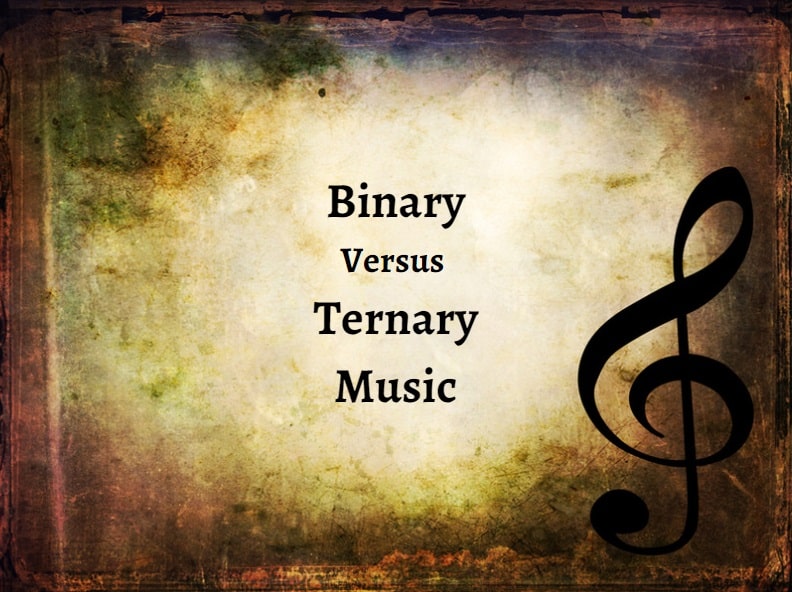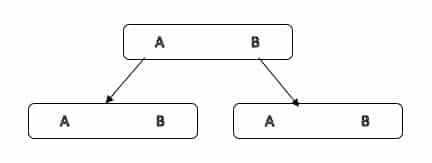
Unless you have had the inclination or opportunity to study theoretical music, then the terms in the title may not be entirely clear. Both terms refer to musical structure; how a piece is made. The binary form is commonly expressed as AB. This is easier to understand than the term itself, as you can see from the expression that there are two parts to this form of music. A straightforward example of binary form music would be a song that included a verse, then a chorus. The reason that there is an ‘A’ then a ‘B’ is because the sections are distinct. In the case of a verse and a chorus, this broadly speaks for itself.
Binary Vs Ternary Music
Ternary form music is no more complicated, but an extension of binary form. The way we express the ternary form is ABA. Following on from the idea that binary comprises two distinct sections of music, in ternary form, the first section returns to end the piece. Sometimes ternary form music has an A2 to conclude the piece that shows there has been a small variation in the original A section just to add interest and to develop the form slightly.
At first glance, then you might assume that these abstract musical forms are not related, but in fact, they depend on one another in a very organic way that forms the heart of many pieces of music. When it comes to a standoff between these well-established musical structures, is there a winner, or are they more like brother and sister rather than arch-rivals?
Composers will often select a musical structure that they feel best suits their creative ideas. Many, like Beethoven, for example, will then push the boundaries of these forms until they almost become a new version of themselves. In judging whether one structure might be superior to the other, we need to look at some illustrations of both types of form. The Baroque composer Scarlatti wrote over five hundred sonatas for the keyboard. His sonatas are mainly in a single movement and the vast majority in binary form. The initial idea is presented ‘A’, followed by a contrasting second idea ‘B’ that although distinct, grown out of the initial material. A is then played again, but in the dominant key, followed by ‘B’ that modulated back to the tonic key. The formula Scarlatti used is completely convincing as a musical structure and satisfying to play and listen to. It offers enough contrast of ideas to maintain interest as well as holding firm as a musical form.
Following on to ternary form, a classic example would be the Da capo aria. The musical form dated back to the Baroque period and was a structure employed with great ingenuity by composers like Bach and Handel. What the words ‘Da capo’ means returns to the ‘head’ of the piece. Practically, this directs the performer to play or, in this case, sing though the composition, both ‘A’ and ‘B’ sections, then return to the ‘A’ section to finish the performance. The traditional view of the Da capo aria would be that the outer ‘A’ sections would be in ¾ time with a contrasting 2/4 or 4/4 ‘B’ section. Different from the Scarlatti example, the Da capo aria would end its ‘A’ section in the tonic key. In essence, it could stop there with a justifiable sense of conclusion, but what was expected in the Baroque rendition of the composition was an embellished or improvised recapitulation of the ‘A’ section. For example, this considers Handel’s ‘The Trumpet Shall Sound’ from Messiah.
What emerges out of these two examples is that on the face of it the binary form is a little more limited in its options than the ternary form. The next level of exploration then must include what I would call ‘compound’ binary and ternary forms of music. What I mean by this is that the binary or ternary forms could be viewed as a description of an overview of a composition that describes a more extensive musical structure.
Example 1.
In this example, I am attempting to demonstrate that in a binary form, you can have sub-sections that make up the original form. In this case, there would be two-parts in the ‘A’ and ‘B’ sections of the music offering many more complex structures whilst remaining broadly in binary form. The initially perceived limitations of binary from then become dissolved in favor of something more detailed and intimately formed. In a real sense, this example could expand further into additional sub-sections if you were composing a piece of sufficient length to sustain the structure.
The ternary form could be subjected to the same sub-levels for longer pieces of music, but it also possible as previously mentioned to vary material and create intricate extensions while remaining true to the original material. In a jazz ‘standard’, the format is usually one of 32 bars in which ‘A’ takes the first sixteen bars and ‘B’ the second sixteen bars. The performer would then repeat the ‘A’ section to finish in most cases. Where the link is between the 32- bar standard and the Da capo aria is improvisation. This opens the chance for the performance and the structure of the music to be almost indefinite, or at least until the performer(s) runs out of ideas. What this would look like as an expression might be something like this: A B A2 B2 A3 B3……
Regardless of which musical form you chose, it is how you use the form that determines the success of the piece. To my mind, there is no clear winner here as a composer using existing structures straight out of the box as it can be entirely competent, and both binary and ternary forms can underpin a wide variety of musical compositions. Where the innovation comes, is through the development of either structure alongside the exploration of the musical material on which it hangs. It is taking an established, tried, and tested concept and doing it in your own way that is most likely to yield imaginative, appealing compositional outcomes.


Dr Wildridge – Nice comprehension . Thanks for writing this out . As a student of the meditative process , I realized a while ago , that music is actually structured brain , in sound . and that the balancing of the events inside of music , are allowing for the theta state to be arrived at . Theta being total stillness, music is like washing the sandy and rocky shore with waves of water that balance out the mind , and allow total interface with the “in between ” arrive . Music will energize a meditation , where as total stillness and silence , will begin to arrive at a harmonic between the sitters reality , and that which is . Listening to music meditatively , which is when you just sit and close you eyes and listen , is a double whammy of wonderfulness . I wanted to write this to offer the concept of balancing and re balancing from all directions to my fellow composers out there in magical music land .